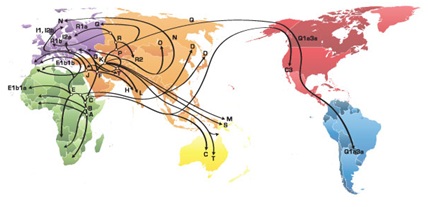Your Mitochondrial DNA & Your Maternal Lineage
Many of our clients often wish to discover and analyse a very specific aspect of their ancestry, wishing to delve into their ancient maternal ancestral roots. EasyDNA is proud to be able to offer an accurate and scientific maternal lineage DNA test.
Thought you had only one type of DNA? Think again. You actually have two types of DNA inside your cells. The type of DNA we analyse for all our DNA tests without exception is what we call nuclear DNA. However, we use another type of DNA when it comes to tracing maternal ancestry and your mother’s blood line. We use a type known as mitochondrial DNA; whilst your nuclear DNA contains tens of thousands of genes, your mitochondrial DNA contains only 37. Analysis of this type of DNA can be indeed revealing. and scientists have for long studied the notion of a mitochondrial eve.
Mitochondrial DNA is special and useful for the following two main reasons:
- It is passed down the maternal line. Both male and female children inherit their mother’s mtDNA but males are incapable of passing this on. This means that this DNA can only be passed on by females.
- Your nuclear DNA, unlike mitochondrial DNA, may sometimes mutate. This means that there may be random changes happening. These random changes can affect, in rare cases, the result of a DNA test. However, mtDNA mutation occurs very, very rarely.

Specifications Of Our Test
Our ancestral origins maternal lineage test is offered start at PHP17,000 . Your results will be made available to you via email in 4-5 weeks.
Learn Your Maternal Lineage By Analysis Of Haplogroups
Analysis of what are called single nucleotide polymorphisms (SNPs) on your mtDNA enable us to determine your haplogroup affiliation and your genetic matrilineality. Understanding haplogroups is key to understanding your deep ancestry. You and your ancestors will share certain genetic sequences or SNPs. These genetic sequences are in turn linked to very specific haplogroups (you can visualize your haplogroup as your own ancestral clan). As your maternal ancestors migrated and moved to different parts of the world, searching for more favorable climates and places to live, they settled in different geographic regions. These studied populations or haplogroups can be linked to your DNA today through identification of shared genetic markers between yourself and these known groups of people in human history.
Wish to view a copy of the maternal lineage certificate? Click here.
We directly test the regions of your mitochondrial DNA that we know code for ancestry. These regions are technically referred to as:
- Hyper variable region 1
- Hyper variable region 2
- Hyper variable region 3
Every one of us has a maternal ancestry that can be linked directly to one of 26 maternal haplogroups. Once we know your haplogroup we will be able to trace the migration steps and patterns of your ancestors, right out of the African continent to other parts of the globe. The geographical regions where those ancestors settled will clearly be shown on your result. We will provide you with a quality map to aid you in better understanding, helping you locate your genetic cousins.
Some points about mitochondrial ancestry testing
- Our matrilineal genetic test is a deep ancestral origins test. It will give you a wealth of information about your ancient maternal lineage but will not tell you, for example, whether you are of French or German origin. Our test goes far, far back before country boarders and the political world map as we know it today even existed.
- The migration routes provided by an ancestry test are fairly accurate but not exact. We trace back your maternal ancestors migration patterns thousands of years. This is the only way of finding your ancient genealogical roots.
- People sharing the same haplogroup are not “relatives” per se. You do share the same ancestry but you are not technically relatives in any way.

